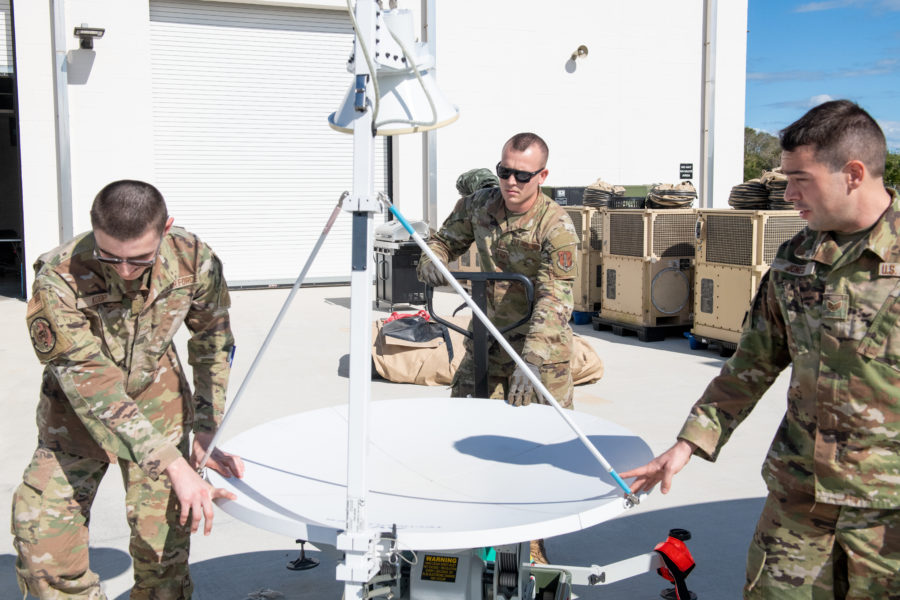The House Armed Services personnel subcommittee advanced legislation June 12 to establish a Space National Guard and to pave the way for part-time Guardians, rather than form a Space Force Reserve.
Subcommittee members voted to turn the 14 units and 1,000 space-focused Airmen in the Air National Guard into a new Space National Guard. Lawmakers also offered a measure that would require the Space Force to maintain a single personnel management system, rather than creating a separate Space Force Reserve.
To become law, the proposals must first clear the House Armed Services Committee when it meets June 23 to vote on amendments, then survive a vote by the full House, and finally survive a conference committee that must reconcile any differences between the House and Senate versions of the final National Defense Authorization Act.
So while still far from certain, the plan represents the most far-reaching step yet in a debate that has been argued since the Space Force was born: Whether or not the National Guard would have a Space mission, and whether or not the Space Force could carve a path to a simpler force management construct than that of the Air Force, with its active and two reserve components.
The question of a Space National Guard has been hotly debated for years. Proponents—including the National Guard Association of the United States (NGAUS), the Air & Space Forces Association (AFA), and lawmakers from states with space-focused units—say a separate Guard is needed because Air National Guard units with space missions are “orphaned” in the current organizational structure, unattached to the Space Force but left with no corresponding Air Force units.
National Guardsmen already provide an indispensable core capability for the Space Force and Space Command. Specifically, “…Airman assigned to 16 units across seven states and one territory provide 60 percent of [our] … space electronic war [capabilities], [and] 50 percent of [our] protected satellite communications.”
“Air National Guard personnel provide fundamental capability to the Space Force today,” said AFA President & CEO Lt. Gen. Bruce Wright, USAF (Ret.) “Logically, moving those Guardsmen into the Space Force is the right thing to do, ensuring space remains under the control of a single service. A New Space National Guard does not need to be large and unwieldly. It can comprise just those units we have today. And it can do so without a lot of complicated infrastructure.”
Critics—including the White House and multiple Senate leaders—argue a Space National Guard would cost too much, create added layers of bureaucracy, and is unnecessary since there are no specific missions for which states need military space forces.
The House has approved Space National Guard proposals before, only to see them die later in the process. In the 2022 and 2023 NDAAs, Space Guard passed the House but were killed in conference when Senate and House leaders reconciled their bills.
The White House and the Pentagon, meanwhile, want a single component and have held to that position for months. What makes this year’s plan different is that the HASC personnel subcommittee appears to have incorporated elements of both ideas.
“We authorize the establishment of the Space National Guard and set a new personnel management benchmark by authorizing the creation of an innovative personnel management system for the Space Force,” subcommittee chair Rep. Jim Banks (R-Ind.) said in a hearing.
The language on the Space National Guard is lifted from the Space National Guard Establishment Act, introduced by Rep. Jason Crow (D-Colo.) earlier this year. The bill looks to address some concerns about cost by specifying that it does not “authorize or require the relocation of any facility, infrastructure, or military installation of the Space National Guard or Air National Guard.” Critics have argued creating a new Guard would require new facilities that would cost hundreds of millions of dollars.
The portion creating the single personnel management system is extensive—140 or so pages—as it adjusts sections of U.S. law dealing with how Reserve forces are typically managed to account for the Space Force’s proposed new structure.
At its heart, the legislation would get rid of the idea of a “Regular Space Force” and a “regular reserve” and create one unified system consisting of full-time, part-time, and inactive Guardians. Those on active status who work full-time will be referred to as on “sustained duty,” while part-time personnel on active status will still need to either:
- Participate in 48 drills or training periods and spend 14 days on active duty
- Spend at least 30 days on active duty
Proponents say such an arrangement would benefit the Space Force by allowing Guardians to more easily switch from full-time to part-time and back again, as compared to the Reserve forces of the other military branches.
The language also clarifies that members of the Air Force Reserve with space-related jobs could transfer over into the Space Force. The Air Force Reserve’s main space-focused unit is the 310th Space Wing, with roughly 1,100 military and civilian personnel.
Still, there are some parts of the legislation that will have to be clarified—while the bill states the Space Force “shall be managed … without component,” the section on the Space Guard states that it will be designated as the “reserve component” of the Space Force.
The Air Force Reserve and Air National Guard are both reserve components for the Air Force, but the Reserve is always under federal control, while the Guard can be activated for state-level missions. A single personnel management system for the Space Force would reduce the number of organizations on the federal level.
